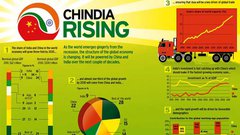Are Australian and NZ businesses missing opportunities in India?
Published 14-APR-2016 12:07 P.M.
|
4 minute read
Hey! Looks like you have stumbled on the section of our website where we have archived articles from our old business model.
In 2019 the original founding team returned to run Next Investors, we changed our business model to only write about stocks we carefully research and are invested in for the long term.
The below articles were written under our previous business model. We have kept these articles online here for your reference.
Our new mission is to build a high performing ASX micro cap investment portfolio and share our research, analysis and investment strategy with our readers.
Click Here to View Latest Articles
The ASX in conjunction with TAT Capital and S&P Capital IQ are collaborating to educate businesses on opportunities they feel are being missed in India.
TAT co-founder and Director Lasanka Perera said while other developed economies have been investing in India for some time, Australia is lagging behind.
“We’ve been so focused on China for the past 20 years that we’re missing the huge potential India has to offer,” he said. “In the present climate it’s the perfect time for us to look to where the next ‘China’ will come from. We are very certain that is India. There are very compelling demographic, political and economic reasons to enhance our economic relationship with India to build a more diversified and energetic regional strategy.”
Back in 2012, Smart Company reported of The $80 billion Indian opportunity that’s too good to ignore.
The Smart Company article states: “China is likely to become the first country that got old before it got rich. India, by way of contrast, has a young population with a median age of 25 – compared with 35.5 years in China and climbing. While Europe, China, the US and Australia have a shrinking workforce and skills shortages because of an ageing population, India has an ever-growing and young labour force which, demographers say, will increase by 135 million by 2020 because of that high birth rate.”
Fast forward to today and the message is the same: it’s time to start doing business with India.
If you want more statistics SP Joshi, country manager for Australian Business International Trade Services cites the following: India’s burgeoning growth (8% to 9% annually) and a strengthening middle class of 350 million people (11% to 12% annual growth).
So why are Australian companies slow to act and why have those who have gone to the Sub-Continent failed?
“It’s frustrating seeing businesses fail because they haven’t partnered with the right people who understand the Indian psyche and how business is conducted in the Sub Continent,” Joshi said.
“I’ve seen some businesses collapse because they decide to go it alone, and considering India’s rapid growth, are wasting valuable opportunities.”
TAT believes businesses looking to sell products and services offshore should put as much or more emphasis on having an India strategy as having a China strategy.
“India is the world’s fastest growing large economy with one of the youngest workforces in the world. Australia and India share many commonalities in the mid-cap space,” Perera said. “In both countries the mid-market wields a lot of economic power, and is where some of the biggest growth opportunities lie.”
The strategy, however, must be long term.
In a statement to Australian Business Consulting and Solutions, Joshi warns businesses intent on trading with India: “you need to have a long term perspective and exercise patience as the gestation period for any business in India is long and Indian markets can often be slow to respond. He says the levels of bureaucracy are a maze but manageable with the assistance of experts ‘on the ground’.”
NSL Consolidated (ASX:NSL) is one Australian company that exemplifies the success Australian companies can have working in India.
NSL has been working closely with the government of Andhra Pradesh on the state’s 15 year business plan which expects 14% growth projected out to 2029, based on an aggressive infrastructure program.
NSL has a Memorandum of Understanding with the government of Andhra Pradesh (GoAP) directly related to mining, beneficiation, and peletisation of low grade iron ores in the state.
Recently NSL secured access to production expansion through additional strategically located mining leases, AP26 and AP27 located in the district of Kurnool, just kilometres from the company’s existing stockyard with its beneficiation plants.
The company also entered a Binding Heads of Agreement on the Lessee executed for the life of the mining leases.
This was all done with the support of GoAP, as part of the NSL/GoAP plans to unlock significant iron ore production potential for NSL in the newly formed state.
The relationship between NSL and GoAP illustrates that strong relationships with bureaucratic entities can further a company’s cause, in line with state ambitions.
Meanwhile, NSL has shown that it can work with both China and India to improve economic outcomes for private and public entities.
NSL recently hosted a team of engineers from equipment provider Huate, one of China’s premier global beneficiation plant suppliers.
The team was there to inspect the plant location and assist with detailed engineering design enabling the generation of final construction plans.
NSL has put itself in a position of strength in India. It seems it has taken SP Joshi’s advice in partnering with the right people, which has been a strategic move from the get-go.
Bottom line: there is enormous opportunity for companies looking for investment, and for investors looking for growth if they follow the rules of engagement.
General Information Only
S3 Consortium Pty Ltd (S3, ‘we’, ‘us’, ‘our’) (CAR No. 433913) is a corporate authorised representative of LeMessurier Securities Pty Ltd (AFSL No. 296877). The information contained in this article is general information and is for informational purposes only. Any advice is general advice only. Any advice contained in this article does not constitute personal advice and S3 has not taken into consideration your personal objectives, financial situation or needs. Please seek your own independent professional advice before making any financial investment decision. Those persons acting upon information contained in this article do so entirely at their own risk.
Conflicts of Interest Notice
S3 and its associated entities may hold investments in companies featured in its articles, including through being paid in the securities of the companies we provide commentary on. We disclose the securities held in relation to a particular company that we provide commentary on. Refer to our Disclosure Policy for information on our self-imposed trading blackouts, hold conditions and de-risking (sell conditions) which seek to mitigate against any potential conflicts of interest.
Publication Notice and Disclaimer
The information contained in this article is current as at the publication date. At the time of publishing, the information contained in this article is based on sources which are available in the public domain that we consider to be reliable, and our own analysis of those sources. The views of the author may not reflect the views of the AFSL holder. Any decision by you to purchase securities in the companies featured in this article should be done so after you have sought your own independent professional advice regarding this information and made your own inquiries as to the validity of any information in this article.
Any forward-looking statements contained in this article are not guarantees or predictions of future performance, and involve known and unknown risks, uncertainties and other factors, many of which are beyond our control, and which may cause actual results or performance of companies featured to differ materially from those expressed in the statements contained in this article. S3 cannot and does not give any assurance that the results or performance expressed or implied by any forward-looking statements contained in this article will actually occur and readers are cautioned not to put undue reliance on forward-looking statements.
This article may include references to our past investing performance. Past performance is not a reliable indicator of our future investing performance.






